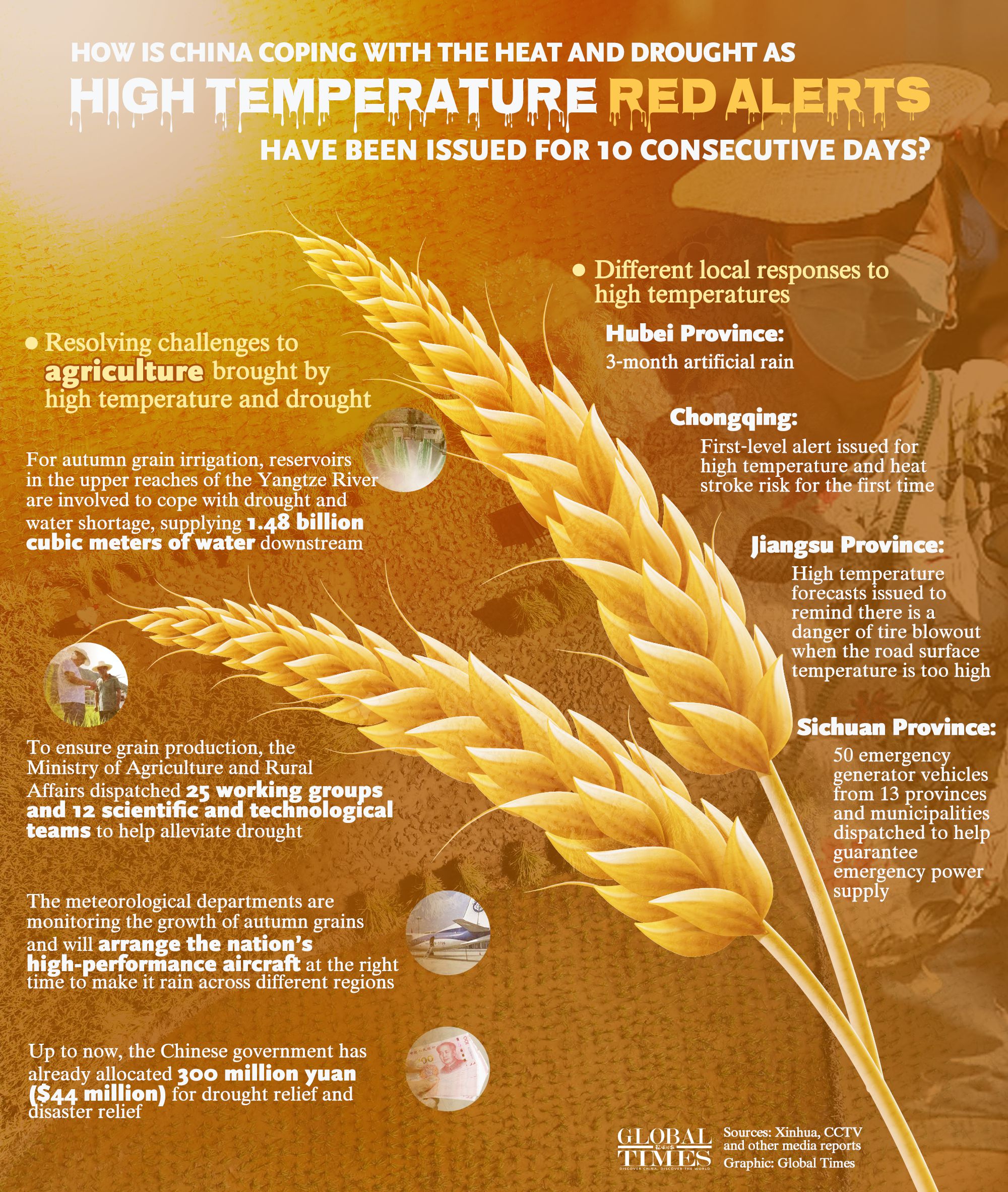China ramps up efforts to alleviate drought for autumn harvest, impact of power shortage limited as 'heat wave to ebb away soon'
As persistent severe heat wave and drought unseen in decades continue to test China's power generation capacity and autumn harvests, relevant government departments have ramped up multiple efforts to ensure power supply and alleviate the impact of the extreme weather on harvest. As the heat wave is expected to ebb away in the later part of August, experts predict the overall influence on the economy will be limited.
On Sunday, China's Central Meteorological Center (CMC) continues to issue red alert - the highest in China's four-tier weather warning system for extreme heat - marking the tenth consecutive days for the agency to publish such alarm.
More than 200 meteorological monitoring stations across the country show temperature in places including Southwest China's Chongqing, Sichuan, East China's Zhejiang and Northwest Shaanxi exceeded 40 C since August 1, media reported.
Meanwhile, some provincial capitals, including Nanjing and Nanchang, did not see a single drop of rain since August. Sichuan, a province which relies on hydropower for approximately 80 percent of its energy supply, is experiencing the most extreme heat wave, and least precipitation in history. The province initiated a top emergency response to ensure energy supply since Sunday.
As of Saturday, the daily hydropower generation capacity of Sichuan dropped by 51.1 percent to 440 million kilowatt-hours from a previous 900 million, media reported.
Xiao Min, a resident in Chengdu, capital of Sichuan province, who works for a tech company, told the Global Times that his company asked employees to work from home for the next week to save energy, and the local government sent him text messages suggesting not to turn the air conditioner lower than 26 C.
"I usually turn it higher than 28 C, and turn it off for a while after I feel cooler … It needs everyone to take initiative to save energy," said Xiao.
The Shanghai on Sunday announced to turn off landscape illumination in certain bustling iconic spots, including the Bund, from Monday to Tuesday, to save energy.
This year's heat wave is the strongest since China started meteorological observations in 1961, and the longest, Sun Shao, a senior research fellow from the Chinese Academy of Meteorological Sciences, told the Global Times. Moreover, an official from the Ministry of Water Resources (MWR) said last week that the Yangtze River basin has had the lowest summer rainfall in six decades.
The drought in most areas of the Yangtze River basin is expected to worsen for at least the next 10 days due to continuous high temperatures and lack of rainfall, Sun told the Global Times, noting that later, the drought in the upper reaches of the Yangtze River will be eased as precipitation will improve but the precipitation in the middle and lower reaches of the river will still be low, making meteorological drought in those areas continue to develop.
He also worries that the drought in the upper stream of some rivers in China may continue to impact the hydro electricity supply in winter.

How is China coping with the heat and drought as high temperature red alerts have been issued for 10consecutive days? Graphic: GT
Limited impact
To alleviate the ordeal of power shortage in Sichuan, 50 emergency generator vehicles from 13 provincial level regions, including Beijing, Shanxi and Jiangsu have been arriving in Sichuan since Thursday to ferry the province out of the power shortage.
Chen Jia, an independent international strategy research fellow, said that the heat wave and drought, plus the fact that production resumption is speeding up in China after the COVID-19 flare-up was contained, and provinces are hiking industrial production capacity, have led to certain regions in China seeing tight energy supplies.
The electricity shortage will exert pressure on production in relevant areas, but the impact is limited, as the heat wave will ebb away soon, and China currently relies mainly on thermal power plants, and it is already latter part of August. Since temperatures in areas north of the Yangtze River are dropping, electricity use will drop in a few weeks, so the power shortage problem will be relieved by the end of August, Cao Heping, an economist at Peking University, told the Global Times on Sunday.
Economists are also concerned about the impact of a lasting drought on autumn harvest, which accounts for 75 percent of China's total grain output, and it is only about 50 days away.
According to the latest number from the Ministry of Water Resources (MWR), 32.99 million arable land was affected by the drought.
The mid-late August is a key period for autumn grain corps to grow in the middle and lower stream of the Yangtze River, said Sun, noting that the persisting heat wave plus drought will reduce the yield of crops such as corn and soybean. Yet he explained that areas with well-functioning irrigation systems can help crops resist the impact of drought, places without irrigation system may bear more impact of the extreme weather.
The Ministry of Agriculture and Rural Affairs held a conference on Friday saying that local governments should continue to spray drought-resistant and water-retaining agent in areas lacking irrigation and watering conditions. For the more severely affected areas, localities should harvest early and develop regenerated rice or late-autumn crops.
According to an official from MWR, China's agricultural irrigated land accounts for half of the total arable area, and yield 75 percent of the nation's grains and 90 percent of economic crops, the Xinhua News Agency reported in 2021.
Energy transformation
Experts said that this summer's situation serves as a reminder for China to always have "emergency energy option," and to phase out coal according to its development pace.
Jin Xiandong, an official of the National Development and Reform Commission, said last week that the commission is guiding relevant enterprises to speed up coal output to cope with rising demand for electricity, and the national average daily dispatched output of coal has been at a relatively high level of about 12.4 million tons since July.
Meanwhile, Europe, which is also experiencing extreme heat and drought, is also seeking help from coal power plants. Starting early August, German hard coal-fired power stations are restarting operations, which were being phased out, German media reported.
According to Chen, in the long term, China should not only have well designed top-level policies and implement them well to pave way for a smooth shift between traditional and new energy, but should enhance energy and environmental protection cooperation globally to learn from other nations how to enhance technological level of power staggering, Chen said.
Lin Boqiang, director of the China Center for Energy Economics Research at Xiamen University, told the Global Times that China is in the middle of an energy structural reform period, as wind power and photovoltaic will eventually replace thermal or water power to become the mainstream power generation mode.
So far, wind power's stability still lags behind thermal or water power, so it's important to break through technological bottlenecks to increase its stability, such as developing technologies like energy storage, intelligent power networks and so forth, said Lin.
Li Fulong, director of the development planning department of the National Energy Administration, said at a news conference in July that China's investment for major energy projects has increased 15.9 percent compared to the same period last year; and for big energy projects started operation this year, investment on non-fossil energy accounts for roughly 87 percent.
Photos
Related Stories
Copyright © 2022 People's Daily Online. All Rights Reserved.









